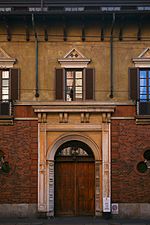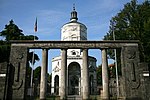Museo Nazionale Scienza e Tecnologia Leonardo da Vinci

Museo Nazionale Scienza e Tecnologia Leonardo da Vinci in Milan, dedicated to painter and scientist Leonardo da Vinci, is the largest science and technology museum in Italy. It was opened on 5 February 1953 and inaugurated by Prime Minister Alcide De Gasperi.The museum, in the ancient monastery of San Vittore al Corpo in Milan, is divided into seven main departments: Materials Transport Energy (including Thermal power station Regina Margherita) Communication Leonardo da Vinci, Art & Science New Frontiers Science for young peopleEach of these departments have laboratories, especially for children and young students. The Transport section is made up of four different parts: air, rail, water and Submarine Enrico Toti-S-506.
Excerpt from the Wikipedia article Museo Nazionale Scienza e Tecnologia Leonardo da Vinci (License: CC BY-SA 3.0, Authors, Images).Museo Nazionale Scienza e Tecnologia Leonardo da Vinci
Via San Vittore, Milan Municipio 1
Geographical coordinates (GPS) Address Phone number Website External links Nearby Places Show on map
Geographical coordinates (GPS)
| Latitude | Longitude |
|---|---|
| N 45.463019444444 ° | E 9.1712388888889 ° |
Address
Museo Nazionale della Scienza e della Tecnologia
Via San Vittore
20123 Milan, Municipio 1
Lombardy, Italy
Open on Google Maps











